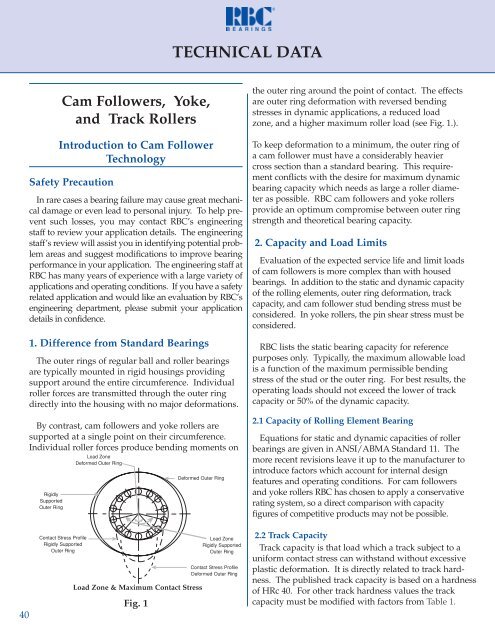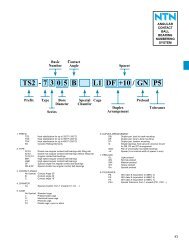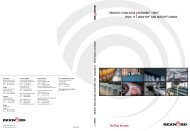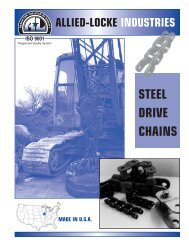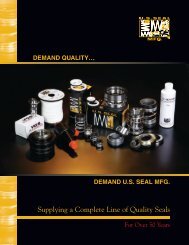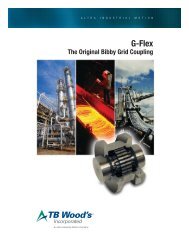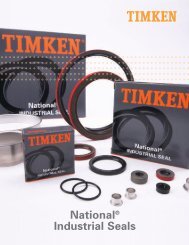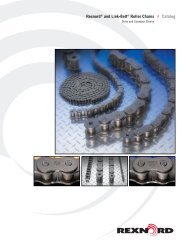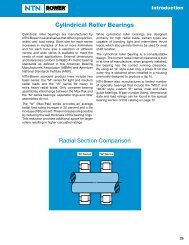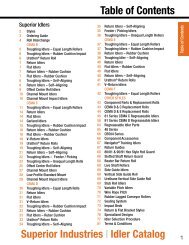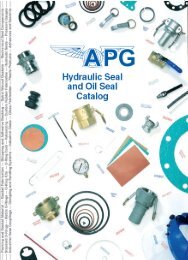1413.06.08 Cam Followers.qxd - RBC Bearings
1413.06.08 Cam Followers.qxd - RBC Bearings
1413.06.08 Cam Followers.qxd - RBC Bearings
- No tags were found...
You also want an ePaper? Increase the reach of your titles
YUMPU automatically turns print PDFs into web optimized ePapers that Google loves.
TECHNICAL DATA<strong>Cam</strong> <strong>Followers</strong>, Yoke,and Track RollersIntroduction to <strong>Cam</strong> FollowerTechnologySafety PrecautionIn rare cases a bearing failure may cause great mechanicaldamage or even lead to personal injury. To help preventsuch losses, you may contact <strong>RBC</strong>’s engineeringstaff to review your application details. The engineeringstaff’s review will assist you in identifying potential problemareas and suggest modifications to improve bearingperformance in your application. The engineering staff at<strong>RBC</strong> has many years of experience with a large variety ofapplications and operating conditions. If you have a safetyrelated application and would like an evaluation by <strong>RBC</strong>’sengineering department, please submit your applicationdetails in confidence.1. Difference from Standard <strong>Bearings</strong>The outer rings of regular ball and roller bearingsare typically mounted in rigid housings providingsupport around the entire circumference. Individualroller forces are transmitted through the outer ringdirectly into the housing with no major deformations.By contrast, cam followers and yoke rollers aresupported at a single point on their circumference.Individual roller forces produce bending moments onRigidlySupportedOuter RingLoad ZoneDeformed Outer RingDeformed Outer Ringthe outer ring around the point of contact. The effectsare outer ring deformation with reversed bendingstresses in dynamic applications, a reduced loadzone, and a higher maximum roller load (see Fig. 1.).To keep deformation to a minimum, the outer ring ofa cam follower must have a considerably heaviercross section than a standard bearing. This requirementconflicts with the desire for maximum dynamicbearing capacity which needs as large a roller diameteras possible. <strong>RBC</strong> cam followers and yoke rollersprovide an optimum compromise between outer ringstrength and theoretical bearing capacity.2. Capacity and Load LimitsEvaluation of the expected service life and limit loadsof cam followers is more complex than with housedbearings. In addition to the static and dynamic capacityof the rolling elements, outer ring deformation, trackcapacity, and cam follower stud bending stress must beconsidered. In yoke rollers, the pin shear stress must beconsidered.<strong>RBC</strong> lists the static bearing capacity for referencepurposes only. Typically, the maximum allowable loadis a function of the maximum permissible bendingstress of the stud or the outer ring. For best results, theoperating loads should not exceed the lower of trackcapacity or 50% of the dynamic capacity.2.1 Capacity of Rolling Element BearingEquations for static and dynamic capacities of rollerbearings are given in ANSI/ABMA Standard 11. Themore recent revisions leave it up to the manufacturer tointroduce factors which account for internal designfeatures and operating conditions. For cam followersand yoke rollers <strong>RBC</strong> has chosen to apply a conservativerating system, so a direct comparison with capacityfigures of competitive products may not be possible.40Contact Stress ProfileRigidly SupportedOuter RingLoad Zone & Maximum Contact StressFig. 1Load ZoneRigidly SupportedOuter RingContact Stress ProfileDeformed Outer Ring2.2 Track CapacityTrack capacity is that load which a track subject to auniform contact stress can withstand without excessiveplastic deformation. It is directly related to track hardness.The published track capacity is based on a hardnessof HRc 40. For other track hardness values the trackcapacity must be modified with factors from Table 1.


